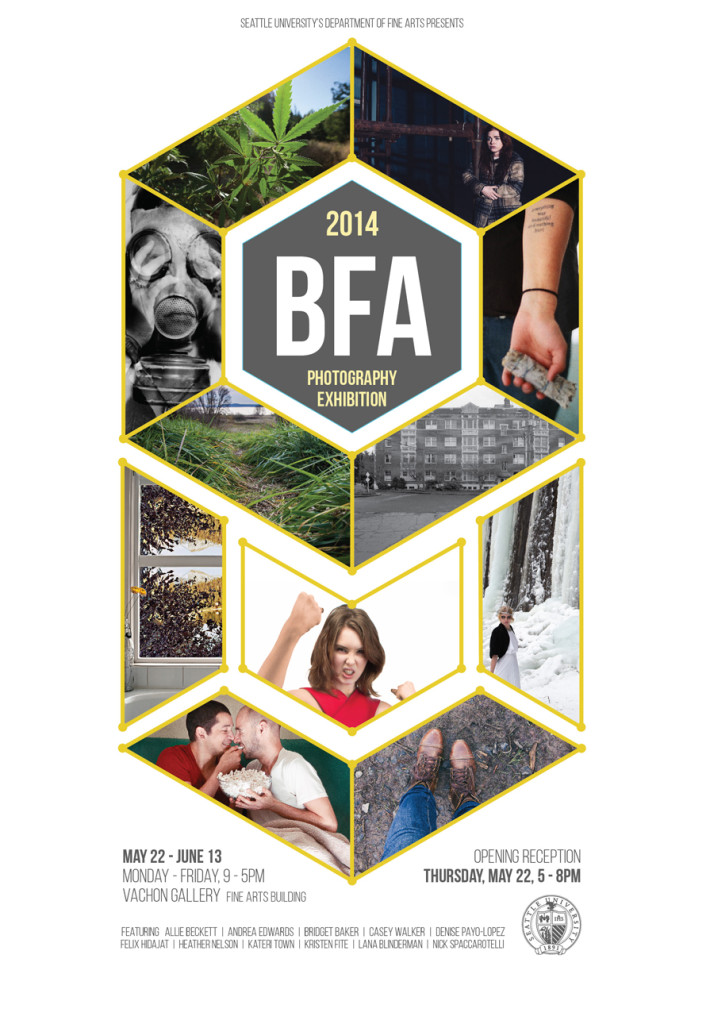In inexperienced hands, a camera may be nothing but a device used to capture selfies that eventually become lost in dark depths of digital storage. But, for BFA photography students, a camera becomes an insightful lens on intriguing personal issues, modern structures and controversial topics.
This year marks the sixth annual BFA Photography Show, an exhibition showcasing the graduating BFA photography students’ cohesive portfolios.
“BFA students spend an entire year on the show,” said Associate Professor of Photography Claire Garoutte.
Garoutte, who has worked at Seattle University since 2004, collaborated with the 11 students on their portfolios throughout this year, guiding them from the conceptualization to the realization of their work.
“This program offers an opportunity for students to really excel, to deeply explore photography [and] to deeply explore the arts,” Garoutte said.
According to Garoutte, realizing an entire portfolio of images for an exhibition is not only very difficult, but also highly unusual for an undergraduate program.
While difficult and unusual, the demanding task of creating a successful body of work has yielded incredible results, such as Andrea Edwards’ project, “Scarlet Letters,” a display of 26 nude individuals draped in a letter from the alphabet.
“The [letters] represent labels, stereotypes and stigmas that the person who is featured in the image has experienced in their lives,” Edwards said.
Each of Edwards’ models wears red fabric that takes the form of the first letter of the label he or she chose. Underneath each image is the model’s written description about their respective word and how it affected them.
According to Edwards, the sensitive subject matter was the most challenging part.
“It’s a very personal thing that I was asking them to do…first to remove their clothing, and then to write about something that has made them feel vulnerable in very many ways,” she said.
Though challenging, the exploration of a deeply intimate topic allowed Edwards to produce a thoughtful and engaging work.
Nicholas Spaccarotelli’s portfolio also challenges an important issue, showcasing the visualization of individuals with HIV from diagnosis to coming to terms.
According to Spaccarotelli, the large, three-foot by four-foot images capture where each person is now, with elements of the people and environments that have helped them cope with HIV.
At the beginning of the year, Spaccarotelli and his fiancé Israel Maldonabo, who is HIV positive, walked into the Lifelong AIDS Alliance one day to ask about photographing patients, and the organization was more than willing to help.
“HIV is a very delicate matter. I was very respectful with how I contacted [the subjects],” he said.
Through this project, Spaccarotelli has become greatly involved with the Lifelong AIDS Alliance and is donating his entire project to the organization, which will be on permanent display in their building.
Other portfolio topics are more controversial, such as Allison Beckett’s documentation of the cannabis industry in Washington.
Beckett has been photographing for Dope Magazine for several years, a publication for medical marijuana patients and enthusiasts.
She aims to be neutral about the subject matter and raise awareness to a new audience that may not be familiar with the plant.
“A lot of people have misconceptions about what [marijuana] is,” Beckett said. “I’m trying to show a more professional approach.”
In her portfolio, she not only presents the stereotypical images of marijuana users, but also the reality of the mainstream culture, stating that she is “trying to bridge that gap.”
The arduous task of composing a distinct and personal body of work has benefitted the students beyond merely artistic expression.
“Students are well prepared to go out in the world and be photographers,” Garoutte said. Her previous students have flourished from this program, many of them continuing on to graduate school, to start their own businesses or to have their own gallery shows.
Both Edwards and Beckett have turned their portfolios into books, both of which will be available to view at the exhibition. Edwards and Beckett are also planning on seeking out publishers for their works in the near future.
All three artists are proud of how their portfolios turned out, and give credit to Seattle U’s extensive program and their adviser, Garoutte.
“If I had not gone to Seattle U then I would not have done this project,” Spaccarotelli said.
Edwards is also very thankful for Garoutte’s wealth of knowledge and expertise.
All 11 students’ distinctive portfolios will be on display in the Vachon Gallery from May 22 to June 14. Artists will also be at the exhibit on the opening night, Thursday, May 22, from 5 to 8 p.m. to answer questions and talk about their work.









